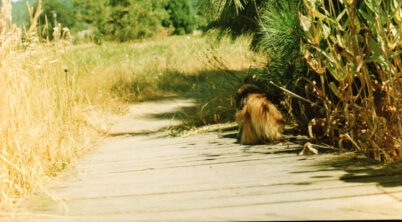The Pekingese dog experiences a reproductive cycle similar to other female canines, which is commonly referred to as estrus or heat. This cycle is an essential aspect of the breed’s reproductive health and includes multiple stages, each characterized by specific physiological and behavioral changes. Recognizing and understanding these stages is crucial for responsible Pekingese ownership, particularly for those interested in breeding.
Beginning with the proestrus stage, a Pekingese will exhibit visible signs such as the swelling of the vulva and a blood-tinged discharge, signaling the onset of the heat cycle. It is important for owners to be aware of these signs to provide proper care and management during this time. Subsequent stages of the cycle involve ovulation, potential for fertilization, and either pregnancy or a return to the normal state if fertilization does not occur.
Not only does the knowledge of the Pekingese’s heat cycle assist in responsible breeding practices, but it also contributes to better overall health care for the dog. Observant owners can ensure that their pet’s needs are met, and any concerns or irregularities in the cycle can be promptly addressed with veterinary consultation.
Table of Contents
Understanding the Pekingese Menstrual Cycle
Learning about a Pekingese’s menstrual cycle is vital for an owner to ensure proper reproductive health management. This section breaks down the hormonal changes and phases of the cycle, as well as the signs and symptoms that accompany it.
Hormonal Changes and Phases
The estrous cycle of a Pekingese dog can be divided into several distinct phases, each driven by hormonal fluctuations. These phases include:
- Proestrus: Marked by the preparation for ovulation, hormones like estrogen rise, signaling the body to start thickening the uterine lining in preparation for a potential pregnancy.
- Estrus: Ovulation occurs during this phase; the female Pekingese is receptive to male dogs. Hormone levels peak and the egg is released from the ovary.
- Diestrus: This phase follows estrus and encompasses either the period of pregnancy or a return to normal reproductive state if fertilization doesn’t happen.
Signs and Symptoms of Estrous
Recognizing the signs and symptoms of a Pekingese in heat is vital for responsible pet care:
- Physical Changes: An enlarged vulva and possible blood-tinged discharge are notable during proestrus.
- Behavioral Changes: A Pekingese may demonstrate changes in behavior such as increased affection or irritability and may urinate more frequently to signal readiness for mating.
Typically, the Pekingese will experience their first heat cycle between six months and a year of age. Understanding these signs and the menstrual cycle’s timeline is crucial for responsible breeding practices and overall reproductive health.
Tracking the Cycle
For Pekingese owners, understanding and tracking the menstrual cycle of their dog is crucial for health management and breeding decisions. Accurate tracking involves observing physical symptoms and behavioral changes, as well as marking dates on a calendar.
Calendar Method
Using a calendar to track a Pekingese’s cycle involves noting the start and end dates of the menstrual bleeding. The owner should mark the first day of visible blood as day one, which marks the beginning of the cycle. This approach allows forecasting of future heat cycles and fertile periods. It is typical for a Pekingese to experience estrus—or heat—approximately every six months, but this can vary individually.
- First Visible Blood: Day 1 of the cycle
- Estimated Duration: Every 6 months (varies)
- Forecasting Future Cycles: Mark estimated dates based on individual patterns
Physical and Behavioral Observations
Tracking physical and behavioral changes in a Pekingese can provide insight into their menstrual cycle. Symptoms may include vaginal discharge, mood changes, discomfort, and mild cramping. Behavioral changes can consist of sudden alterations in affection levels, appetite, and energy. Monitoring these signs closely facilitates a deeper understanding of the cycle and better preparation for its associated needs.
- Symptoms to Observe:
- Vaginal discharge
- Discomfort or mild cramping
- Mood fluctuations
- Behavioral Changes:
- Variations in affection and attention-seeking behavior
- Changes in appetite
- Energy level shifts
Accurate recording of these observations supports responsible Pekingese ownership and health care.
Health and Reproductive System
Maintaining the health and proper functioning of the Pekingese’s reproductive system is essential for overall well-being and reproductive success. Regular veterinary check-ups can identify potential issues early, while knowledge of reproductive indicators helps owners recognize if intervention is needed.
Importance of Regular Veterinary Check-Ups
Regular veterinary examinations are crucial for assessing the reproductive health of a Pekingese. Veterinarians specifically check the uterus, ovaries, and vagina for signs of normal function and potential complications. These check-ups can prevent latent health issues and aid in maintaining fertility. A checklist during veterinary visits may include:
- Physical Examination: Assess overall health; palpate abdomen for uterine or ovarian abnormalities.
- Reproductive Assessment: Evaluate signs of heat, potential for breeding, and examine for any reproductive irregularities.
- General Health Screening: Rule out signs of eating disorders, cancer, or other systemic conditions that can affect reproductive health.
Recognizing Reproductive Issues
Awareness of the Pekingese’s estrous cycle is vital for recognizing reproductive issues. Signs of reproductive complications may include:
- Irregularities in the Heat Cycle: An irregular cycle can suggest hormonal imbalances or physiological problems.
- Discharge or Bleeding: Abnormalities in discharge or excessive bleeding may indicate infections or other health concerns.
- Changes in Behavior or Appetite: Significant changes can be indicative of discomfort or reproductive issues.
Owners should monitor their Pekingese for these signs and seek veterinary attention if irregularities or concerning symptoms arise. Early detection and treatment contribute to the overall reproductive health of a Pekingese.
Fertility and Breeding
Understanding the fertility and breeding patterns of Pekingese dogs is crucial for responsible breeding practices. This section outlines the optimal timing for mating and provides insights into the pregnancy and birth process of Pekingese.
Optimal Timing for Mating
Fertility in Pekingese typically begins between 6 and 12 months of age, as these dogs enter their first heat cycle. The heat cycle occurs approximately twice a year and lasts for 18 to 24 days. To increase the chances of successful breeding, it is important to identify when the female is most fertile. This fertile period, known as estrus, is when the female is receptive to mating and can conceive.
During estrus, an owner can look for several signs to determine the optimal breeding time:
- Changes in behavior, such as increased affection or restlessness
- Physical signs, including a swollen vulva or light bleeding
- The female may also exhibit ‘flagging,’ where she lifts her tail to the side
Pregnancy and Birth in Pekingese
After successful mating, pregnancy in Pekingese lasts on average between 58 and 63 days. Pekingese are a toy breed, and due to their small size, the litter size can range from 1-3 puppies. Owners should provide attentive care throughout the pregnancy, ensuring the expecting mother has a well-balanced diet and regular veterinary check-ups.
During pregnancy, an ultrasound can confirm the presence of a fetus and help monitor its development. As birth approaches, the expectant Pekingese should have a quiet, comfortable space for whelping. The owner should monitor the birthing process for any complications, as toy breeds like the Pekingese may require veterinary assistance or even a cesarean section due to the size of the puppies and the size of the birth canal.
Managing Menstrual Health
A Pekingese’s heat cycle requires careful management to ensure her overall well-being. The dog owner should focus on maintaining proper nutrition and exercise routines, as well as ensuring hygiene and comfort during this time.
Nutrition and Exercise
Proper nutrition is vital for a Pekingese in heat. It should include high-quality foods rich in essential nutrients to support her health, addressing potential issues such as weight gain during her cycle. Exercise should continue but may need to be adjusted in terms of intensity; light physical activity can help manage discomfort while maintaining her physical health.
- Nutritional Considerations:
- High in protein and essential fatty acids
- Sufficient calcium for bone health
- Balanced meals that prevent unnecessary weight gain
- Physical Activity Adjustments:
- Light walks instead of high-intensity play
- Shorter but more frequent exercise sessions
- Monitoring for any signs of discomfort or pain during activity
Hygiene and Comfort
Maintaining hygiene is crucial to prevent infections during a Pekingese’s menstrual cycle. Frequent cleaning of her bedding and any areas where she rests is recommended. For comfort, soft bedding and a quiet, stress-free environment help alleviate any potential distress or discomfort.
- Hygienic Practices:
- Regular cleaning of the Pekingese’s bedding and living spaces
- Dog-safe wipes can be used to clean her if she’s bleeding
- Monitor for any signs of infection and consult a vet if necessary
- Comfort Enhancements:
- Provide soft, clean bedding for rest
- Ensure a calm environment, minimizing stress and anxiety
- Consider the use of dog diapers to manage discharge and maintain cleanliness
Appropriate treatment of any discomfort or pain is also essential and should be under the guidance of a veterinarian.
Menstrual Irregularities and Disorders
Menstrual irregularities in Pekingese can encompass a variety of disorders, each requiring specific veterinary attention. Understanding the common issues and recognizing when professional help is necessary are crucial steps in maintaining the reproductive health of these dogs.
Common Issues
Pekingese may experience several menstrual irregularities, which can be symptomatic of underlying health conditions. Irregular cycles are one notable symptom, and they can sometimes signal a condition like polycystic ovary syndrome (PCOS), though less common in dogs than in humans. Irregularities can also include:
- Anestrus: Extended periods without estrus cycles.
- Oligomenorrhea: Infrequent menstrual bleeding.
The onset of menopause is another phase where irregularities occur but is perfectly normal.
When to Seek Professional Help
Immediate veterinary care should be pursued if the Pekingese exhibits signs such as:
- Severe pain: Indicated by excessive whimpering or agitation.
- Abnormalities in bleeding patterns, suggesting possible implantation or other conditions.
Established treatment plans may include hormonal therapies or surgical interventions, depending on the diagnosis. It is pivotal for the health of the Pekingese to address these issues promptly.
Influences of Hormones on Behavior
The behavior of Pekingese during their menstrual cycle is markedly influenced by hormonal changes, specifically estrogen, progesterone, and luteinizing hormone, which can affect mood and comfort levels.
Behavioral Changes During the Cycle
During different phases of the menstrual cycle, a Pekingese may exhibit various behavioral changes. In the early stages, estrogen levels start to rise, often leading to more playful and energetic behavior. When progesterone increases after ovulation, the dog might display more nesting behaviors and seek more comfort from its environment. The surge in luteinizing hormone can trigger readiness for mating, causing restlessness or increased affection-seeking behaviors.
- Estrus (Heat) Phase: Markedly increased activity, interest in male dogs, possible nervous behavior.
- Proestrus and Diestrus Phases: Possible clinginess, nesting, or withdrawal from play.
- Anestrus Phase: Typically, a phase of neutral behavior, with reduced influence of hormones.
Impact of Hormones on Mood and Comfort
Hormones not only influence behavior but also affect a Pekingese’s mood and comfort. Fluctuations in estrogen and progesterone, particularly before and after estrus, can lead to increased irritability or discomfort. Some dogs may experience premenstrual syndrome-like symptoms, including minor headaches, reflected through sensitivity to touch or a desire for solitude.
- Mood: Variability linked to hormonal fluctuations. May be observant through changes in interaction with humans and other dogs.
- Comfort: Physical discomfort due to bodily changes could lead to restlessness and a need for cozy, quiet spaces.
It is crucial for pet owners to note these shifts in behavior and comfort and provide a supportive environment during their Pekingese’s menstrual cycle.
Preventing Unwanted Puppies
Responsible Pekingese ownership involves managing the dog’s reproductive health to prevent unwanted puppies. Two primary methods for controlling reproduction are birth control methods and spaying, which are essential for mitigating accidental breeding.
Birth Control Methods
Owners have various birth control methods at their disposal to prevent their Pekingese from becoming pregnant. The use of doggy diapers during the estrous cycle can deter mating efforts from male dogs. Strict supervision while the female is in heat, typically lasting about three weeks, is crucial to avoid any unscheduled mating encounters. Additionally, chemical birth control options are available, but may have side effects and should always be discussed with a veterinarian.
Benefits of Spaying
Spaying, the surgical removal of a female dog’s reproductive organs, is highly effective in preventing pregnancy. This procedure not only eliminates the chance of an unexpected litter but also ceases the menstrual cycle, negating the seasonal management of a dog in heat. Health benefits are significant, including a reduced risk of certain cancers and reproductive diseases. Spaying is best done before the first heat cycle, between six months and one year of age for a Pekingese, but can be performed at various life stages under a veterinarian’s guidance.
* Banner photo by donnaidh_sidhe, cropped | Some rights reserved








